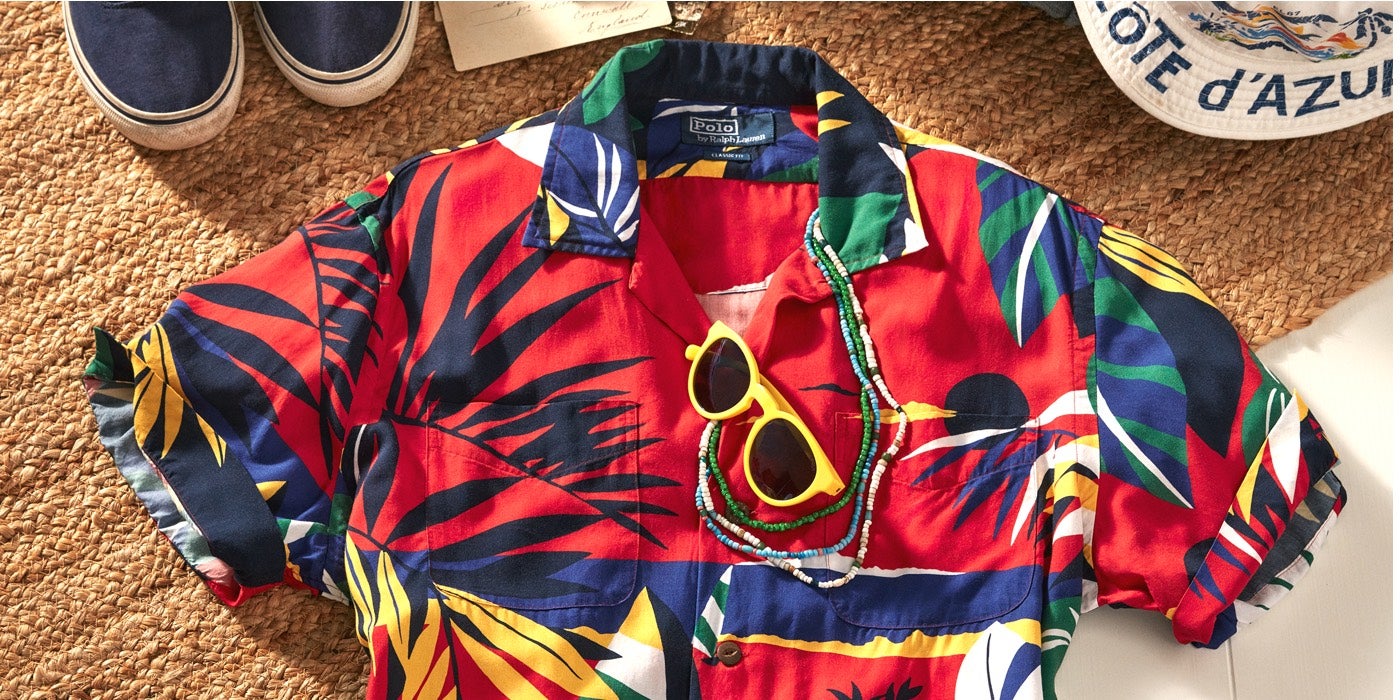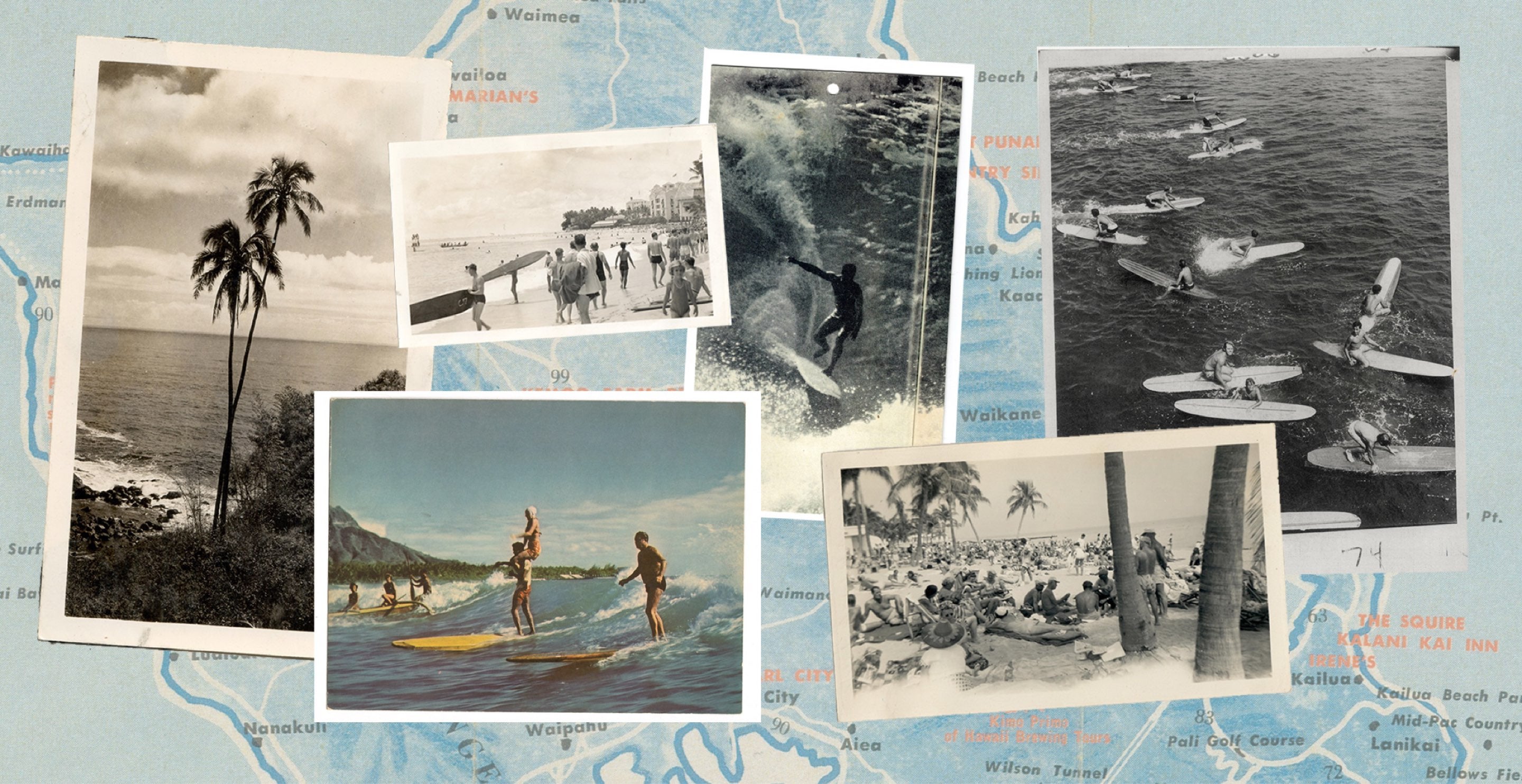
Woven With History
Almost every summer, Polo unveils a few new designs and color combinations of aloha shirts, which have long been one of our most beloved American classics to interpret with maximum creativity. Its beginnings travel through various Pacific cultures, feature an American president, and remind us all that getting dressed can be fun.Woven With History
Almost every summer, Polo unveils a few new designs and color combinations of aloha shirts, which have long been one of our most beloved American classics to interpret with maximum creativity. Its beginnings travel through various Pacific cultures, feature an American president, and remind us all that getting dressed can be fun.
The phrase “timeless novelty” might be a bit of an oxymoron, but it also might be the only way to accurately describe one of the more fun and unique entries in Ralph Lauren’s long-running, must-have styles: the aloha shirt. Decade after decade, Ralph has put his spin on the breezy silhouette and island-inspired prints of Hawaii’s most famous sartorial export. Each year, you’ll find a fresh lineup of them, in new prints and patterns, in Polo’s spring and summer collections without fail.
But the style predates Polo by about 40 years—so first, a history lesson. The exact origin of the shirt is a matter of some debate since there are a few different claims to the fame of its invention. What is certain, though, is that it comes from a unique mix of Pacific cultures. The loose-fitting silhouette, sans print, first gained popularity in the late 19th century as the kind of island equivalent of workwear, with a button-front design adapted from imported Western garments and a boxy silhouette meant to be worn untucked, perhaps adapted from a shirt called the barong tagalog which was worn by Filipino sugar field workers. Sometime in the 1920s, Chinese tailors in Hawaii took Japanese fabrics—cloth that might have been intended for kimonos—and stitched them up into something entirely new. And, thus, the “aloha shirt” was born.

From top left, Elvis takes up the ukulele; Harrison Ford in The Mosquito Coast; Tom Selleck as Magnum PI; Brad Pitt in Once Upon a Time in Hollywood; and Montgomery Clift in From Here to Eternity.
As international tourism surged with the advent of the commercial airline industry, the style was quick to take off. Tourists took them back home as souvenirs, and they became a bit of a status symbol for the well-traveled. As the decades moved along towards Hawaii’s statehood in 1959, the style grew dramatically in America’s sartorial consciousness—President Truman wore one on the cover of Life in 1951, and 10 years later, Elvis immortalized the aloha in Blue Hawaii. And that was basically that: A new iconic American style, from a new American state, was cemented into the menswear canon.
For Ralph, the aloha shirt has long been a staple of warm-weather collections and a canvas for the fun and finely detailed prints that comprise a key part of Polo’s sensibility. Each design starts in the artistic studio of the Polo prints department, where the inspiration could be almost anything—an authentic Hawaiian vintage reference; a well-loved sample from the Polo archives; or an idea worked out from scratch. Dozens of versions are designed, colorized, scaled up and down, twisted and turned, and edited until a suite of options is ready for Ralph’s review. The highest compliment Ralph gives is when he says a print is ready to go, with no notes. “Just put sleeves on it,” he likes to say.
After serving in World War I, Rube P. Hoffman, who had spent his formative years working in New York City’s garment district, landed in Los Angeles. Seeing an opportunity to stake a claim in the burgeoning textile business, in 1924 he started Hoffman California Fabrics, International (originally named Hoffman Woolens) in downtown LA. But it wasn’t until his sons—Walter “Big Wal” and Philip “Flippy”—got into the family business that things took on a decidedly more California direction. An early member of the post–World War II bohemian surf culture, Walter drew from his formative experiences in the Hawaiian Islands to lead the company in a fresh new direction. Jumping back and forth between the South Pacific and the West Coast, by the late ’50s the Hoffman brothers were back in California and running the family business—albeit with a much more surfy, Polynesian sensibility. The rest, as they say, is history. For the better part of 100 years, Hoffman California Fabrics has brought beauty and an unmatched sense of creativity to its textiles. With his feet firmly planted in the sand, Walter has never wavered from his artistic vision or the lifestyle he’s endeavored to create. “Family is everything,” Hoffman says. “I’d quit and retire if my family wasn’t involved.” Below, he reflects on joining the family business, surfing in Hawaii with the greats, and a life lived according to his own rules.

When did you decide to get involved in your father’s business—how did that come about?
I couldn’t make a living in Hawaii, so I came back and started working with my father. Before I came in, they were doing a lot of different solid color textiles. We hired an artist and did some Hawaiian art that we made prints with, and I would sell those in the back. We were in Los Angeles at the time. My brother came in, and he got us to move to Costa Mesa. After a couple of years, we bought some land in Mission Bay, and that’s where we are today.
When it comes to selecting textiles and prints, what are some of the things that have been successful over the years—how do you know what’s going to work and what isn’t?
First of all, it has to be beautiful and have good colors—you kind of have a feeling about what’s going to work. And we listen to our customers and learn from them. The goal is to develop prints that make you happy and feel good. Florals always sell. We’d do about 75 percent florals and 25 percent other prints.


You’re very passionate about surfing. How did that start?
My first trip to Hawaii was in 1949. When I got out of school, I went there with a friend to surf. When I was in the service, I got to choose what I wanted to do, so I signed up for the supply center in Hawaii. We worked from 5 to 9 at night, so we got to surf all the time.
Where did you surf and who were some of the greats you surfed with?
In the summertime, we surfed Waikiki. And in the wintertime, we’d surf Mākaha and Sunset Beach on the North Shore. In the ’50s, we rented a Quonset hut at Mākaha, and I got a lot of guys to come over from the mainland and stay during the winter. My brother and Buzzy Trent came over and ended up staying. We even got Phil Edwards to come over. It was great. If eight guys were in the water surfing at that time, that would be crowded.
What’s one of your favorite surf stories of all time?
One time I was out at Mā’ili Point in Hawaii with George Downing and the waves were big. We were out at the Cloudbreak, which is a good half of a mile out, and the waves were so big we couldn’t even catch them. You’d start paddling, and you didn’t know where the wave started and stopped. You’d be paddling halfway up the thing, and you didn’t even know it. We all lost our boards on a big set and had to swim to shore. Those were the biggest waves I was ever in. I would say it was 30 feet. I wasn’t really that scared; I was a pretty good swimmer.

A selection of some of the Aloha prints Polo has produced over the years.
Hawaiian motifs—tropical fauna, beachgoers, crashing waves, palm trees—feature heavily, of course, but Ralph and his team of artists have never limited themselves strictly to the aloha shirt’s island tableaux. Inspirations have ranged from nautical and sail racing to Art Deco poster art, Ralph’s vintage automobile collection, and roulette tables. (See: Polo’s famed “Casino shirt” from the ’90s.)
Case in point is a few of our favorite aloha shirt prints from this season. For classic island vibes, you’ve got a bright green background overlaid with multicolored flora, boats, and a Polo Bear shredding some waves. A two-tone beach tableau in blue and white captures the spirit of Hawaiian beachgoers but with an international influence: The illustration is inspired by Art Deco renditions of the French Riviera. In collaboration with Hoffman Fabrics—a legendary pioneer of aloha prints since the ’50s—there’s a scarlet red sunset scene, with sailboats and palm fronds. And for something a bit more offbeat, you’ve got a watercolor-tinged Parisian print inspired by fin de siècle poster art from the City of Light.



While Polo’s aloha shirts have been fabricated in cotton, seersucker, linen, and lots more over the years, the most classic and traditional fabric for an aloha shirt, and the one used for the four above, is one Polo returns to the most: rayon. This breezy synthetic silk, also known as viscose, couldn’t be more perfect for an aloha shirt: It’s lightweight and breezy, quick to dry, drapes beautifully, boasts an elegant hand feel, is easy as can be to care for, and, maybe most importantly, is excellent at absorbing and retaining colored dye, perfect for the bright colors that are essential to the definition of an aloha shirt.
Ease is the operative concept, including how to wear them. What we say is: just about any way you like. Try one buttoned up under a linen sport coat or worn open over a ribbed tank top or striped T-shirt. Pair one with cutoff shorts and bare feet on vacation, or some faded chinos and beat-up loafers on the weekend. The only rule, to the extent an aloha shirt can have one, is this: have fun with it.







